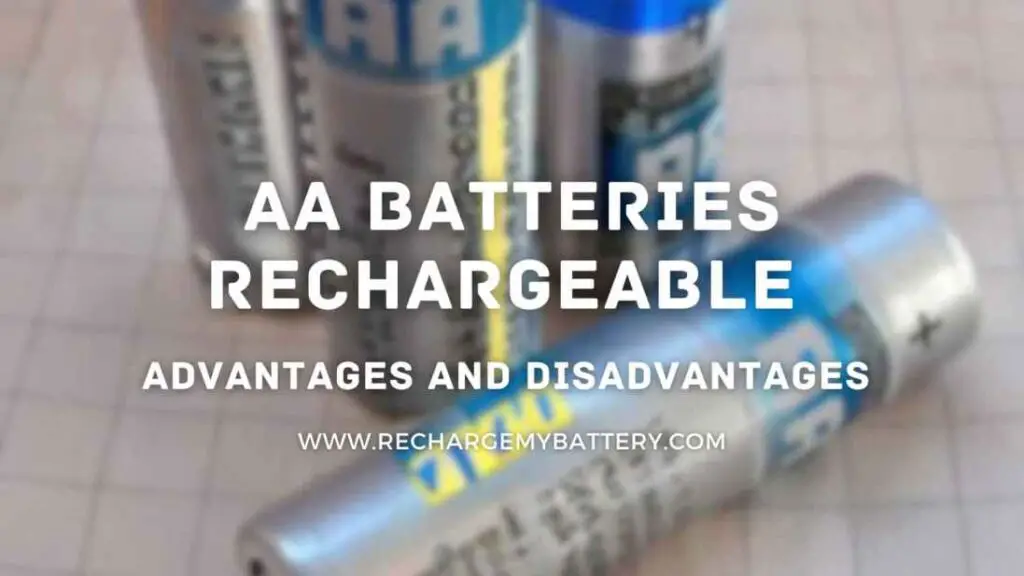You may have noticed that rechargeable AA batteries are typically labeled as 1.2V, while alkaline AA batteries are labeled as 1.5V. In this article, we will explore the reasons behind this voltage difference and delve into the unique characteristics of these battery types.
Understanding Battery Voltage
To understand why rechargeable AA batteries have a voltage of 1.2V while alkaline AA batteries have a voltage of 1.5V, it is crucial to grasp the concept of battery voltage. Voltage is a measure of the electrical potential difference between two points in a circuit. It represents the force that drives the flow of electric current. In simple terms, voltage determines the battery’s ability to deliver power to a device.
Rechargeable AA Batteries: The Chemistry Behind 1.2V
Rechargeable AA batteries typically operate at a voltage of 1.2V due to their underlying chemical composition. Two common types of rechargeable batteries that fall under this category are Nickel-Metal Hydride (NiMH) batteries and Lithium-Ion (Li-ion) batteries.
Nickel-Metal Hydride (NiMH) Batteries
NiMH batteries utilize a combination of nickel oxyhydroxide and a metal hydride as the active components in their positive and negative electrodes. The chemical reactions taking place within the battery result in an average voltage output of around 1.2V. This chemistry allows NiMH batteries to be recharged multiple times, making them a popular choice for various portable electronic devices.
Lithium-Ion (Li-ion) Batteries
Lithium-Ion batteries, often used in high-performance devices like smartphones and laptops, also operate at approximately 3.7V. However, when used in applications that require 1.2V, such as AA batteries, a voltage regulation circuit is incorporated to step down the voltage to the desired level. This circuit ensures compatibility with devices designed for 1.2V rechargeable AA batteries.
Advantages of Rechargeable AA Batteries
Rechargeable AA batteries offer several advantages over their alkaline counterparts, despite the slight voltage difference.
1. Cost Savings
While rechargeable AA batteries may have a higher upfront cost, they can be recharged and reused multiple times, making them more cost-effective in the long run. Instead of repeatedly buying disposable alkaline batteries, investing in rechargeable batteries reduces overall expenses.
2. Environmental Impact
Disposable alkaline batteries contribute to environmental pollution due to their one-time use and improper disposal. Rechargeable AA batteries significantly reduce waste by minimizing the number of batteries that end up in landfills. They are a more sustainable option, leading to a reduced carbon footprint.
3. Convenience
Having rechargeable AA batteries on hand eliminates the need for frequent trips to the store to purchase disposable batteries. With rechargeable batteries, you can simply recharge them using a compatible charger whenever they run out of power. This convenience is especially beneficial in situations where a constant power supply is required.
Alkaline AA Batteries: The Chemistry Behind 1.5V
Alkaline AA batteries, commonly found in households, operate at a nominal voltage of 1.5V. These batteries use a chemical reaction between manganese dioxide and zinc to produce electrical energy. The voltage output of alkaline batteries is higher than that of rechargeable batteries due to their specific chemical composition.
Comparing Rechargeable AA Batteries and Alkaline AA Batteries
Now, let’s compare rechargeable AA batteries and alkaline AA batteries in various aspects:
1. Voltage Difference
The primary distinction between these two battery types is the voltage difference. Rechargeable AA batteries have a lower voltage of 1.2V, while alkaline AA batteries operate at a higher voltage of 1.5V.
2. Capacity
Rechargeable AA batteries generally have a lower capacity compared to alkaline AA batteries. This means that rechargeable batteries may not last as long in high-drain devices that require a significant amount of power.
3. Self-Discharge Rate
Rechargeable AA batteries have a higher self-discharge rate compared to alkaline AA batteries. This means that they lose their charge over time, even when not in use. Alkaline batteries, on the other hand, have a lower self-discharge rate, allowing them to retain their power for a longer duration.
4. Cost
As mentioned earlier, rechargeable AA batteries have a higher initial cost but can be recharged multiple times. Alkaline AA batteries are less expensive upfront but need to be replaced once they are depleted.
Applications and Considerations
The choice between rechargeable AA batteries and alkaline AA batteries depends on the specific application and individual preferences. Here are a few factors to consider:
1. High-Drain Devices
High-drain devices, such as digital cameras and flashlights, often require a higher voltage and greater power output. In such cases, alkaline AA batteries with their 1.5V voltage may be more suitable.
2. Low-Drain Devices
For low-drain devices like remote controls and clocks, where power consumption is minimal, rechargeable AA batteries can be a cost-effective and environmentally friendly option.
3. Voltage Compatibility
Some devices are designed to operate within a specific voltage range. It is essential to check the manufacturer’s recommendations to ensure compatibility between the device and the battery. While most devices can accommodate the slight voltage difference between rechargeable and alkaline AA batteries, it’s always best to verify.
Conclusion
The voltage difference between rechargeable AA batteries (1.2V) and alkaline AA batteries (1.5V) is primarily due to their respective chemical compositions. Rechargeable AA batteries utilize nickel-metal hydride (NiMH) or lithium-ion (Li-ion) chemistry, which naturally produces a lower voltage. Despite this difference, rechargeable AA batteries offer cost savings, environmental benefits, and convenience. Alkaline AA batteries, with their higher voltage, are suitable for high-drain devices. Ultimately, the choice between these battery types depends on specific requirements and personal preferences.
FAQs
Q1. Can rechargeable AA batteries be used in place of alkaline batteries?
Yes, in most cases, rechargeable AA batteries can be used as a suitable replacement for alkaline batteries, provided the device can accommodate the slightly lower voltage.
Q2. Are there any safety concerns with rechargeable AA batteries?
Rechargeable AA batteries are generally safe to use. However, it’s essential to handle them according to the manufacturer’s instructions and avoid exposing them to extreme temperatures or physical damage.
Q3. Do rechargeable AA batteries last as long as alkaline batteries?
Rechargeable AA batteries usually have a lower capacity compared to alkaline batteries, meaning they may not last as long in high-drain devices. However, they can be recharged and reused multiple times, making them more cost-effective in the long run.
Q4. Can rechargeable AA batteries be charged with a standard battery charger?
Yes, rechargeable AA batteries can typically be charged using a standard battery charger designed for the specific battery chemistry (NiMH or Li-ion). It’s crucial to use a compatible charger to ensure safe and efficient charging.
Q5. Are there any risks of using alkaline batteries in devices designed for rechargeable batteries?
Using alkaline batteries in devices designed for rechargeable batteries is generally safe. However, alkaline batteries cannot be recharged and may leak or cause damage if subjected to high temperatures or incorrectly inserted into the device.

